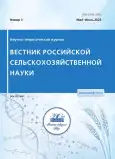Increasing the productive potential of large and small cattle breed resources in the South of Russia based on modern breeding methods
- Authors: Gorlov I.F1, Slozhenkina M.I1, Anisimova E.Y.2, Karpenko E.V2, Mosolova D.A2
-
Affiliations:
- Volga region research institute of manufacture and processing of meat-and-milk production, Volgograd State Technical University
- Volga region research institute of manufacture and processing of meat-and-milk production
- Issue: No 3 (2023)
- Pages: 76-82
- Section: Articles
- URL: https://journals.rcsi.science/2500-2082/article/view/147908
- DOI: https://doi.org/10.31857/2500-2082/2023/3/76-82
- EDN: https://elibrary.ru/QONOHV
- ID: 147908
Cite item
Full Text
Abstract
About the authors
I. F Gorlov
Volga region research institute of manufacture and processing of meat-and-milk production, Volgograd State Technical University
Email: niimmp@mail.ru
M. I Slozhenkina
Volga region research institute of manufacture and processing of meat-and-milk production, Volgograd State Technical University
E. Yu Anisimova
Volga region research institute of manufacture and processing of meat-and-milk production
E. V Karpenko
Volga region research institute of manufacture and processing of meat-and-milk production
D. A Mosolova
Volga region research institute of manufacture and processing of meat-and-milk production
References
- Батанов С.Д., Амерханов Х.А., Баранова И.А. и др. Молочная продуктивность коров разных экстерьерно-конституциональных типов // Известия Тимирязевской сельскохозяйственной академии. 2021. № 2. С. 102-113.
- Иванов Р.В., Захарова Л.Н. Проблемы адаптации завозных специализированных пород крупного рогатого скота // Сибирский вестник сельскохозяйственной науки. 2020. Т. 50. № 3. С. 94-102.
- Илькив Н. Генетика КРС: новые возможности // Эффективное животноводство. 2022. № 3 (178). С. 62-71.
- Колосова М.А., Колосов А.Ю., Бакоев Ф.С. ДНК-маркеры продуктивности в свиноводстве // Вестник Донского государственного аграрного университета. 2019. № 4-1 (34). С. 16-20.
- Мусаева И.В., Алиева Р.М. Генетические маркеры мясной продуктивности овец // Известия Дагестанского ГАУ. 2022. № 1 (13). С. 61-64.
- Селионова М.И., Плахтюкова В.Р. Мясная продуктивность бычков казахской белоголовой породы разных генотипов по генам CAPN1 и GH // Молочное и мясное скотоводство. 2020. № 4. С. 9-12.
- Сычёва О.В., Кононова Л.В. Генетические маркеры в молочном скотоводстве // Аграрно-пищевые инновации. 2018. № 1 (1). С. 27-31.
- Тихомиров А.И. Экономическая эффективность технологической модернизации и интенсификации животноводства России // Экономика сельскохозяйственных и перерабатывающих предприятий. 2022. № 12. С. 21-24.
- Шендаков А.И. Влияние голштинской породы на генофонд черно-пестрого скота в стадах Орловской области // Молочное и мясное скотоводство. 2022. № 1. С. 17-20.
- Konovalova, E. Romanenkova O., Zimina A. et al. Genetic variations and haplotypic diversity in the myostatin gene of different cattle breeds in Russia // Animals (Basel). 2021. V. 11. № 10. A. 2810.
- Al-Thuwaini T.M., Al-Shuhaib M.B.S., Lepretre F., Dawud H.H. Two co-inherited novel SNPs in the MC4R gene related to live body weight and hormonal assays in Awassi and Arabi sheep breeds of Iraq // Veterinary Medicine and Science. 2021. V. 7. № 3. P. 897-907.
- Haruna I.L., Li Y., Ekegbu U.J. et al. Associations between the bovine myostatin gene and milk fatty acid composition in New Zealand Holstein-Friesian × Jersey-Cross cows // Animals (Basel). 2020. V. 10. № 9. P. 1447.
- Valencia C.P.L., Franco L.Á.Á., Herrera D.H. Association of single nucleotide polymorphisms in the CAPN, CAST, LEP, GH, and IGF-1 genes with growth parameters and ultrasound characteristics of the Longissimus dorsi muscle in Colombian hair sheep // Tropical Animal Health and Production. 2022. V. 54. № 1. A. 82.
- Wang F., Chu M., Pan L. et al. Polymorphism Detection of GDF9 gene and its association with litter size in Luzhong Mutton Sheep (Ovis aries) // Animals (Basel). 2021. V. 11. № 2. A. 571.
- Yan W., Zhou H., Hu J. et al. Variation in the FABP4 gene affects carcass and growth traits in sheep // Meat Science. 2018. V. 145. P. 334-339.
Supplementary files










